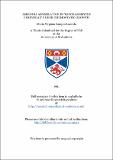Ammonia assimilation in 'Saccharomyces cerevisiae' under chemostatic growth
Abstract
In order to investigate the effect of the elimination of GOGAT activity in S. cerevisiae, the pool sizes of ammonia, glutamate and glutamine plus the specific activities of the enzymes involved in ammonia assimilation were determined for two genetically engineered strains (AR2 and AR5) and an haploid wild type ( Sigma 1278b). AR2 and AR5 strains carry the plasmid pCYG4 which directs about 5 fold more NADPH-GDH activity than wild type cells. AR5 strain is a double mutant, which lacks GOGAT activity. The studies were carried out using a microprocessor-controlled fermenter (PCS) which has the following features: 3 Main Boards (Central Processor Board, Memory Board and Analog/Digital - ON/OFF Switch Board). 4 Auxiliary Boards (pH, Oxygen, Temperature and Biomass Interface Boards). A connection block to link the PCS with the video terminal, with sensors from the fermenter, with a control box and with other microcomputer. AR2 and AR5 showed lower values of maximum specific growth rates than the wild type, determined either by batch mode or by washout kinetics. The reduction in the growth rate for AR2 and AR5 can be related to the added metabolic loads due to the plasmid encoded genes. Under carbon limitation there were no remarkable differences between the NADPH-GDH activities of AR2 (GOGAT+) and AR5 (GOGAT-). However, the concentrations of glutamate and glutamine for AR2 were higher (from 20 to 40 %) than those of AR5. The lack of the GOGAT activity also resulted in a decrease in the biomass concentration for AR5 compared to the GOGAT+ strains. Under nitrogen limitation NADPH-GDH activities were higher and intracellular ammonia concentrations lower than under carbon limited conditions. The intracellular concentrations of glutamate and glutamine were higher for the GOGAT+ strain than for the GOGAT- one. Although the biomass level was the same for the three strains, AR5 (GOGAT") cells changed from rounded to ellipsoidal form under nitrogen limited conditions. Oscillations were present in the NADPH-GDH activities of AR2 and AR5 strains growing under carbon and nitrogen limited media. They are probably due to segregational instability of the plasmid pCYG4 in these microorganisms.
Type
Thesis, PhD Doctor of Philosophy
Collections
Items in the St Andrews Research Repository are protected by copyright, with all rights reserved, unless otherwise indicated.

